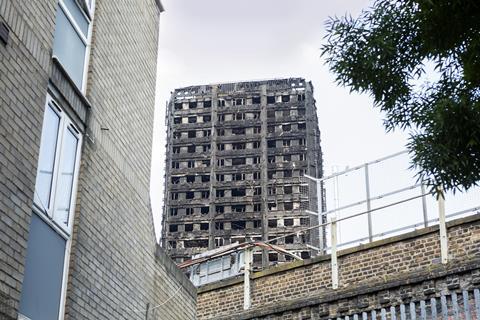Legislation plans regulator for buildings over 18m, new homes ombudsman and tougher regulatory framework for construction products
The ║├╔ź¤╚╔˙TV Safety Bill is a pivotal moment in the history of UK construction and the industry must embrace the chance to make far-reaching reforms, the head of the Construction Industry Council has said.
Chief executive Graham Watts told ║├╔ź¤╚╔˙TV it was critical that industry stepped up as the government published its long-awaited legislation intended to force changes in an industry whose collective failures have been exposed by the ongoing Grenfell Inquiry.

Watts said: ÔÇťMore than 40 yearsÔÇÖ of deregulation is being reversed by the ║├╔ź¤╚╔˙TV Safety Bill with its important emphasis on a national rather than local regulatory regime for higher-risk buildings.
ÔÇťThe early sight of proposals for draft statutory instruments is particularly welcome in terms of understanding issues relating to the eventual implementation of the legislation.
ÔÇťIt is essential that the industry does not see this as being just about high-rise residential and fire safety but as a lever for far-reaching cultural reform. We all have to take the life safety of those who use our buildings far more seriously than in the past.ÔÇŁ
The bill, drawn up to make sure another tragedy like the Grenfell fire four years ago doesnÔÇÖt happen again, was presented to the Commons without debate yesterday afternoon. No date has been announced for its second reading. It contains measures to introduce a new regulator for buildings over 18m, a new homes ombudsman, a tougher regulatory framework for construction products and enhanced powers for the Architects Registration Board (Arb).
Rebecca Rees, a partner at law firm, Trowers & Hamlins who has been advising on the Hackitt Review and guiding clients on building safety, described it as a ÔÇťdense and technical piece of legislationÔÇŁ.
She added: ÔÇťIt deserves detailed scrutiny but quite clearly the pre-legislative plea for more detail has been heard: resulting in an additional 27 clauses. In fact, it is clear that MHCLG has been in listening mode with lots of additional detail included to tease out the challenges created by complex ownership structures, multi-tenure buildings and the hot potato question of ÔÇśwho paysÔÇÖ.
ÔÇťAlongside the previous provisions on the establishment of a new ║├╔ź¤╚╔˙TV Safety Regulator, New Homes Ombudsman and Resident Engagement Panel, further detail has also been included: the definition of a higher-risk building (including what it means for one to be ÔÇśoccupiedÔÇÖ); there is now a ÔÇśprincipalÔÇÖ accountable person; extensive competency provisions; and the ability for a special measures order where management is not up to scratch.ÔÇŁ
Peter Hogg, UK cities director at Arcadis, said the measures would ÔÇťfocus the minds of the supply-sideÔÇŁ by making clear that government sees safety in tall buildings to be industryÔÇÖs responsibility.
Of measures to extend the period of time that homeowners have to sue over shoddy workmanship, he said: ÔÇťThe retrospective nature of the extension to liability also makes clear that government sees remedying historic issues as the industryÔÇÖs problem to solve.ÔÇŁ
But he added: ÔÇťLooking at the plight of leaseholders in buildings that are blighted by historic issues, the bill does not see the government stepping in, nor does it see them mandating developers and contractors to pick up the tab. The requirement for developers only to demonstrate that they have looked at alternatives before passing costs to leaseholders is not the answer that many leaseholders were desperately hoping for. It is an answer that will leave many in a state of continued uncertainty.ÔÇŁ
And Jonathan Frankel, litigation partner at property law specialists Cavendish Legal Group, said housing secretary Robert Jenrick was wrong to suggest the move would put more cards in the hands of the leaseholder.
ÔÇťIt simply delays the period of limitation to allow them to bring legal challenges,ÔÇŁ he said. ÔÇťAs such, issues of representation and funding for any legal action and subsequent repairs will continue to be the major obstacle for most leaseholders.
ÔÇťPolitically this feels like the government is simply kicking the can down the road which will actually prolong the pain for leaseholders further. In my view there is no benefit to extending the limitation period without helping leaseholders fund potential legal actions. ThatÔÇÖs the change we want to see.ÔÇŁ
The UK Cladding Action Group described the legislation as the ÔÇťultimate betrayal of innocent victimsÔÇŁ.
> Tory MP says ║├╔ź¤╚╔˙TV Safety Bill a ÔÇśsticking plasterÔÇÖ
But others welcomed the bill. Judith Hackitt, chair of the Independent Review of ║├╔ź¤╚╔˙TV Regulations and Fire Safety and author of the Hackitt Review which was commissioned after the Grenfell fire, said: ÔÇťI am delighted that we have reached this important milestone for the ║├╔ź¤╚╔˙TV Safety Bill. It is vital that we focus on getting the system right for the future and set new standards for building safety.
ÔÇťResidents and other stakeholders need to have their confidence in high rise buildings restored and those who undertake such projects must be held to account for delivering safe buildings.ÔÇŁ
Alan Kershaw, chair of the Arb, offered a warm welcome to ÔÇťa significant milestoneÔÇŁ, while Scott Steedman, director general of standards at the BSI, said: ÔÇťOver time we expect that the combination of the new bill and the competence standards will bring a much-needed change of culture to the entire built environment sector and long-term benefits to the public, living and working in buildings, to the workers in the sector and to the building owners.ÔÇŁ
Jonathan Moulam, president of the Association for Project Safety, said the bill offered the opportunity to ÔÇŁreset building safety in England by designing safety in and appointing a safety expert to every team when projects are being developedÔÇŁ.


























No comments yet